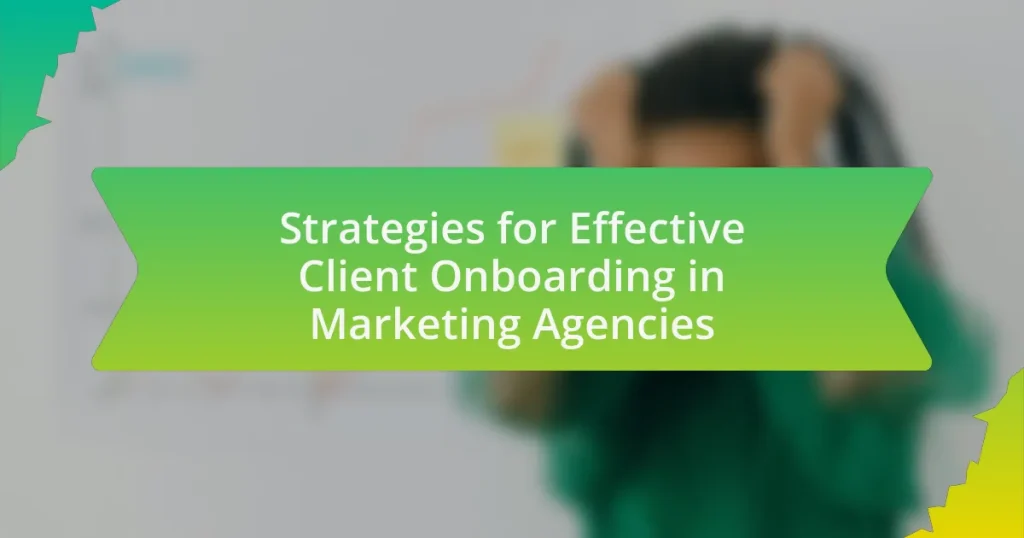The article focuses on strategies for effective client onboarding in marketing agencies, emphasizing the importance of clear communication, comprehensive documentation, personalized strategy development, and ongoing support. It outlines how understanding client needs enhances the onboarding process and discusses various methods for gathering client requirements, such as interviews and surveys. The role of communication in establishing expectations and maintaining client relationships is highlighted, along with best practices for ongoing engagement. Additionally, the article addresses common challenges faced during onboarding and provides insights on measuring success through key performance indicators, ultimately aiming to improve client satisfaction and retention rates.

What are the key components of effective client onboarding in marketing agencies?
The key components of effective client onboarding in marketing agencies include clear communication, comprehensive documentation, personalized strategy development, and ongoing support. Clear communication establishes expectations and builds trust, while comprehensive documentation ensures that all client information and project details are accurately recorded. Personalized strategy development tailors marketing efforts to the client’s specific needs and goals, enhancing engagement and effectiveness. Ongoing support provides clients with continuous assistance and feedback, fostering a long-term relationship and improving client satisfaction. These components collectively contribute to a streamlined onboarding process that enhances client retention and success.
How does understanding client needs enhance the onboarding process?
Understanding client needs enhances the onboarding process by allowing marketing agencies to tailor their services and communication strategies effectively. When agencies identify specific client requirements, they can create personalized onboarding experiences that address those needs, leading to increased client satisfaction and engagement. Research indicates that personalized experiences can improve client retention rates by up to 30%, demonstrating the tangible benefits of understanding client needs during onboarding.
What methods can be used to gather client requirements effectively?
To gather client requirements effectively, marketing agencies can utilize methods such as interviews, surveys, workshops, and observation. Interviews allow for in-depth discussions, enabling agencies to understand client needs and expectations clearly. Surveys can reach a broader audience, collecting quantitative data that highlights common requirements. Workshops facilitate collaborative brainstorming, fostering a shared understanding of project goals among stakeholders. Observation provides insights into client operations, revealing implicit needs that may not be articulated. These methods are supported by industry practices that emphasize the importance of clear communication and stakeholder engagement in requirement gathering.
How can agencies tailor their services based on client insights?
Agencies can tailor their services based on client insights by systematically analyzing client feedback and preferences to customize their offerings. This involves collecting data through surveys, interviews, and analytics to understand client needs and expectations. For instance, a study by McKinsey & Company found that companies that leverage customer insights effectively can increase their revenue by 10-15%. By integrating these insights into service design, agencies can enhance client satisfaction and retention, ensuring that their services align closely with client objectives and market demands.
What role does communication play in client onboarding?
Communication is essential in client onboarding as it establishes clarity, builds trust, and ensures alignment between the agency and the client. Effective communication facilitates the exchange of vital information, such as project goals, expectations, and timelines, which are crucial for a successful partnership. Research indicates that 70% of clients cite poor communication as a primary reason for dissatisfaction, highlighting the importance of clear and consistent dialogue throughout the onboarding process. By actively engaging clients through regular updates and feedback loops, agencies can foster a collaborative environment that enhances client satisfaction and retention.
How can agencies establish clear communication channels with clients?
Agencies can establish clear communication channels with clients by implementing structured communication plans that define roles, responsibilities, and preferred communication methods. This approach ensures that both parties understand how and when to communicate, reducing misunderstandings. For instance, regular check-ins, scheduled meetings, and the use of project management tools can facilitate ongoing dialogue. Research indicates that 70% of clients prefer regular updates, highlighting the importance of consistent communication in maintaining strong client relationships.
What are the best practices for maintaining ongoing communication during onboarding?
The best practices for maintaining ongoing communication during onboarding include establishing clear communication channels, setting regular check-ins, and providing timely feedback. Clear communication channels, such as dedicated email threads or project management tools, ensure that all parties can easily share information and updates. Regular check-ins, scheduled weekly or bi-weekly, help to address any concerns and keep the onboarding process on track. Timely feedback allows new clients to understand their progress and make necessary adjustments, fostering a collaborative environment. These practices enhance client engagement and satisfaction, ultimately leading to a more successful onboarding experience.
Why is setting expectations crucial in the onboarding process?
Setting expectations is crucial in the onboarding process because it establishes a clear understanding of roles, responsibilities, and outcomes between the agency and the client. This clarity helps to prevent misunderstandings and miscommunications, which can lead to dissatisfaction and project delays. Research indicates that 70% of clients who have a clear understanding of project expectations report higher satisfaction levels, as they feel more engaged and informed throughout the process. By defining specific goals, timelines, and deliverables upfront, agencies can foster a collaborative environment that enhances trust and accountability, ultimately leading to successful project outcomes.
What specific expectations should be communicated to clients?
Clients should be informed about the scope of services, timelines, communication protocols, and performance metrics. Clearly defining the scope of services ensures clients understand what is included in the engagement, preventing misunderstandings. Timelines set expectations for project milestones and deliverables, fostering accountability. Communication protocols outline how often and through which channels updates will be provided, ensuring transparency. Performance metrics establish benchmarks for success, allowing clients to gauge the effectiveness of the services rendered. These expectations are critical for building trust and ensuring a productive working relationship.
How can agencies ensure clients understand their roles and responsibilities?
Agencies can ensure clients understand their roles and responsibilities by implementing a structured onboarding process that includes clear communication, detailed documentation, and regular check-ins. This approach allows agencies to outline expectations, deliverables, and timelines explicitly, which helps clients grasp their involvement in the project. For instance, providing a comprehensive onboarding guide that details each party’s responsibilities can significantly enhance understanding. Research indicates that effective onboarding can improve client satisfaction and project outcomes, as evidenced by a study from the Harvard Business Review, which found that organizations with structured onboarding processes experience a 50% increase in client retention rates.

What strategies can improve the client onboarding experience?
To improve the client onboarding experience, marketing agencies should implement personalized communication, streamlined processes, and comprehensive training resources. Personalized communication fosters a sense of connection and trust, as clients feel valued and understood. Streamlined processes, such as automated workflows and clear timelines, reduce confusion and enhance efficiency, leading to quicker integration. Comprehensive training resources, including detailed guides and video tutorials, empower clients to utilize services effectively, increasing satisfaction and retention. Research indicates that organizations with effective onboarding processes can improve client retention rates by up to 50%, demonstrating the significant impact of these strategies.
How can technology streamline the onboarding process?
Technology can streamline the onboarding process by automating repetitive tasks and enhancing communication. Automation tools, such as digital forms and e-signatures, reduce paperwork and speed up data collection, allowing agencies to focus on client relationships. Additionally, project management software facilitates real-time collaboration and tracking, ensuring that all stakeholders are aligned and informed throughout the onboarding journey. According to a study by McKinsey, companies that leverage digital tools in their onboarding processes can reduce onboarding time by up to 50%, demonstrating the effectiveness of technology in improving efficiency and client satisfaction.
What tools are available to facilitate client onboarding in marketing agencies?
Client onboarding in marketing agencies can be facilitated by tools such as CRM software, project management platforms, and onboarding automation tools. CRM software like HubSpot or Salesforce helps manage client relationships and track interactions, ensuring a smooth onboarding process. Project management platforms such as Trello or Asana enable agencies to organize tasks and timelines, improving collaboration and communication with clients. Onboarding automation tools like Typeform or DocuSign streamline the collection of client information and contract signing, reducing manual effort and enhancing efficiency. These tools collectively enhance the onboarding experience by improving organization, communication, and efficiency.
How can automation enhance efficiency during onboarding?
Automation can enhance efficiency during onboarding by streamlining repetitive tasks and reducing manual errors. By implementing automated systems, marketing agencies can manage client data entry, document collection, and communication processes more effectively. For instance, automated workflows can ensure that all necessary forms are sent to clients promptly, and reminders can be set for follow-ups, which minimizes delays. According to a study by McKinsey, organizations that automate onboarding processes can reduce onboarding time by up to 50%, allowing teams to focus on more strategic activities. This efficiency not only accelerates the onboarding timeline but also improves the overall client experience, leading to higher satisfaction rates.
What training and resources should be provided to clients?
Clients should be provided with comprehensive training on the agency’s services, tools, and processes. This training should include detailed tutorials on using marketing platforms, understanding analytics, and implementing strategies effectively. Additionally, resources such as user manuals, FAQs, and access to a dedicated support team should be made available to ensure clients can navigate challenges independently. Research indicates that effective onboarding can increase client retention rates by up to 50%, highlighting the importance of thorough training and accessible resources in fostering successful client relationships.
How can agencies create effective onboarding materials for clients?
Agencies can create effective onboarding materials for clients by developing clear, structured content that outlines processes, expectations, and key information. This includes creating comprehensive guides that detail services, timelines, and communication protocols, ensuring clients understand their roles and responsibilities. Additionally, incorporating visual aids such as flowcharts and infographics can enhance comprehension and retention of information. Research indicates that structured onboarding processes can improve client satisfaction and retention rates, with studies showing that effective onboarding can lead to a 50% increase in client engagement.
What types of training sessions are beneficial for new clients?
Interactive workshops are beneficial training sessions for new clients. These workshops facilitate hands-on learning and engagement, allowing clients to actively participate in discussions and exercises related to their specific needs. Research indicates that interactive training sessions enhance retention of information by up to 75%, compared to traditional lecture-based formats, which typically yield a retention rate of only 5-10%. Additionally, personalized onboarding sessions tailored to the client’s industry and goals can significantly improve their understanding of services and expectations, leading to a smoother transition and stronger client-agency relationships.
How can feedback be utilized to refine the onboarding process?
Feedback can be utilized to refine the onboarding process by systematically collecting and analyzing input from new clients regarding their experiences. This input allows marketing agencies to identify pain points and areas for improvement in the onboarding journey. For instance, a study by the Harvard Business Review found that organizations that actively seek feedback during onboarding can increase client satisfaction by up to 30%. By implementing changes based on this feedback, agencies can enhance the clarity of communication, streamline processes, and ultimately foster stronger client relationships.
What methods can be used to collect client feedback during onboarding?
Surveys and questionnaires are effective methods to collect client feedback during onboarding. These tools can be distributed electronically or in person, allowing clients to provide structured responses about their onboarding experience. Research indicates that 70% of clients prefer giving feedback through online surveys due to their convenience and anonymity. Additionally, one-on-one interviews can yield qualitative insights, enabling deeper understanding of client needs and expectations. Implementing feedback forms at various stages of the onboarding process also helps in capturing real-time insights, which can be crucial for improving the overall experience.
How can agencies implement changes based on client feedback?
Agencies can implement changes based on client feedback by systematically collecting, analyzing, and integrating the feedback into their processes. This involves establishing a structured feedback mechanism, such as surveys or interviews, to gather insights directly from clients about their experiences and expectations. Once the feedback is collected, agencies should categorize and prioritize the responses to identify common themes and actionable items. For instance, if multiple clients express concerns about communication frequency, the agency can adjust its communication strategy accordingly. Research indicates that organizations that actively respond to client feedback can improve client satisfaction by up to 30%, demonstrating the effectiveness of this approach.

What are the common challenges faced during client onboarding?
Common challenges faced during client onboarding include miscommunication, lack of clarity in expectations, and inadequate resource allocation. Miscommunication often arises from differing terminologies or assumptions between the agency and the client, leading to misunderstandings about project goals. A lack of clarity in expectations can result in clients not fully understanding the services provided, which may lead to dissatisfaction. Inadequate resource allocation, such as insufficient time or personnel dedicated to the onboarding process, can hinder the establishment of a strong client-agency relationship. According to a study by HubSpot, 70% of clients report that poor onboarding experiences negatively impact their perception of the agency, highlighting the importance of addressing these challenges effectively.
What obstacles can hinder effective client onboarding?
Ineffective communication can significantly hinder client onboarding. When marketing agencies fail to clearly convey expectations, processes, and timelines, clients may feel confused or misinformed, leading to frustration and disengagement. According to a study by HubSpot, 70% of clients cite poor communication as a primary reason for dissatisfaction with service providers. Additionally, lack of personalized onboarding experiences can create barriers; clients often require tailored approaches to feel valued and understood. Research from the Customer Experience Professionals Association indicates that 86% of buyers are willing to pay more for a better customer experience, highlighting the importance of addressing these obstacles to enhance onboarding effectiveness.
How can agencies identify potential issues early in the onboarding process?
Agencies can identify potential issues early in the onboarding process by implementing structured communication and feedback mechanisms. Regular check-ins with clients during the initial stages can reveal misunderstandings or unmet expectations, allowing agencies to address concerns promptly. Research indicates that 70% of client dissatisfaction stems from poor communication, highlighting the importance of proactive engagement. Additionally, utilizing onboarding surveys can help agencies gauge client satisfaction and identify areas of concern before they escalate.
What strategies can be employed to overcome these challenges?
To overcome challenges in client onboarding for marketing agencies, implementing a structured onboarding process is essential. This process should include clear communication of expectations, timelines, and deliverables to ensure alignment between the agency and the client. Research indicates that 70% of clients prefer a structured onboarding process, as it enhances their understanding and satisfaction (Source: HubSpot, “The Importance of Client Onboarding,” 2021). Additionally, utilizing onboarding software can streamline tasks and improve efficiency, allowing agencies to track progress and maintain engagement. By focusing on these strategies, marketing agencies can effectively address common onboarding challenges and foster stronger client relationships.
How can agencies measure the success of their onboarding strategies?
Agencies can measure the success of their onboarding strategies through key performance indicators (KPIs) such as client retention rates, time to first value, and client satisfaction scores. By analyzing client retention rates, agencies can determine how many clients continue to engage after the onboarding process, indicating the effectiveness of their strategies. Time to first value measures how quickly clients begin to see results from the services provided, which reflects the efficiency of the onboarding process. Client satisfaction scores, often gathered through surveys, provide direct feedback on the onboarding experience, allowing agencies to identify areas for improvement. These metrics collectively offer a comprehensive view of onboarding success, enabling agencies to refine their strategies based on data-driven insights.
What key performance indicators should be tracked during onboarding?
Key performance indicators that should be tracked during onboarding include client engagement rate, time to first value, completion rate of onboarding tasks, and client satisfaction scores. Client engagement rate measures how actively clients interact with onboarding materials, indicating their interest and understanding. Time to first value assesses how quickly clients begin to see benefits from the service, which is crucial for retention. Completion rate of onboarding tasks reflects how many clients finish the onboarding process, highlighting potential barriers. Client satisfaction scores provide direct feedback on the onboarding experience, helping to identify areas for improvement. Tracking these indicators allows marketing agencies to optimize their onboarding strategies effectively.
How can client satisfaction be assessed post-onboarding?
Client satisfaction can be assessed post-onboarding through surveys, interviews, and performance metrics. Surveys, such as Net Promoter Score (NPS) or Customer Satisfaction Score (CSAT), provide quantitative data on client perceptions and experiences. Interviews allow for qualitative insights, enabling deeper understanding of client needs and expectations. Performance metrics, including project timelines and deliverables, can indicate satisfaction levels based on whether client goals are met. Research shows that companies using structured feedback mechanisms see a 20% increase in client retention, highlighting the effectiveness of these assessment methods.
What are the best practices for ensuring a smooth onboarding experience?
The best practices for ensuring a smooth onboarding experience include establishing clear communication, setting expectations, and providing comprehensive training. Clear communication fosters transparency and builds trust between the agency and the client, which is essential for a successful partnership. Setting expectations involves outlining project timelines, deliverables, and roles, ensuring that both parties are aligned from the start. Comprehensive training equips clients with the necessary tools and knowledge to engage effectively with the agency’s services, enhancing their confidence and satisfaction. Research indicates that organizations with structured onboarding processes experience 54% greater new hire productivity, highlighting the importance of these practices in achieving a seamless onboarding experience.
How can agencies create a checklist for effective onboarding?
Agencies can create a checklist for effective onboarding by identifying key steps that ensure a smooth transition for new clients. This checklist should include elements such as gathering essential client information, defining project goals, establishing communication protocols, and setting timelines. Research indicates that structured onboarding processes can improve client satisfaction and retention rates, with studies showing that effective onboarding can increase client retention by up to 50%. By systematically addressing these components, agencies can enhance their onboarding experience and foster stronger client relationships.
What tips can help agencies maintain a positive client relationship from the start?
Agencies can maintain a positive client relationship from the start by establishing clear communication and setting expectations. Clear communication ensures that both parties understand project goals, timelines, and deliverables, which fosters trust and transparency. According to a study by the Project Management Institute, effective communication can improve project success rates by up to 20%. Additionally, setting realistic expectations helps prevent misunderstandings and disappointment, as clients are more likely to feel satisfied when they know what to expect. By prioritizing these strategies, agencies can create a strong foundation for a successful partnership.


